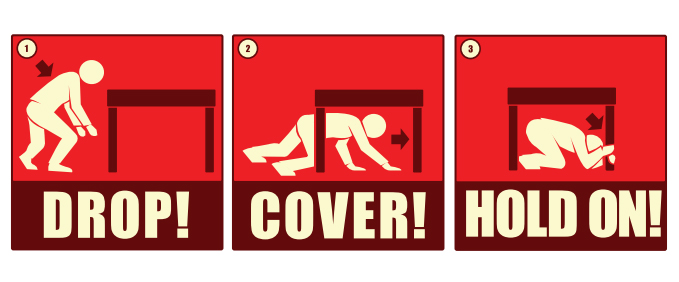From Ready.gov
An earthquake is the sudden, rapid shaking of the earth, caused by the breaking and shifting of underground rock. Earthquakes can cause buildings to collapse and cause heavy items to fall, resulting in injuries and property damage. Earthquakes can:
- Happen anywhere – though higher risk areas include California, Alaska, and the Mississippi Valley;
- Happen without warning;
- Cause fires and damage roads; and
- Cause tsunamis, landslides, and avalanches.
If an earthquake happens, protect yourself right away. Drop, Cover, then Hold On!
- If in a vehicle, pull over and stop.
- If in bed, stay there.
- If outdoors, stay outdoors.
- Do not get in a doorway.
- Do not run outside.
When the Earth Shakes
Earthquake planning and preparation
- Secure items, such as televisions, and objects that hang on walls. Store heavy and breakable objects on low shelves.
- Practice Drop, Cover, then Hold On with family and coworkers. Drop to your hands and knees. Cover your head and neck with your arms. Crawl only as far as needed to reach cover from falling materials. Hold on to any sturdy furniture until the shaking stops.
- Create a family emergency communications plan that has an out-of-state contact. Plan where to meet if you get separated.
- Make a supply kit that includes enough food and water for at least three days, a flashlight, a fire extinguisher, and a whistle. Consider each person’s specific needs, including medication. Do not forget the needs of pets. Have extra batteries and charging devices for phones and other critical equipment.
- Consider obtaining an earthquake insurance policy. Standard homeowner’s insurance does not cover earthquake damage.
- Consider a retrofit of your building to correct structural issues that make it vulnerable to collapse during an earthquake.
During an earthquake
- Drop, Cover, then Hold On like you practiced. Drop to your hands and knees. Cover your head and neck with your arms. Hold on to any sturdy furniture until the shaking stops. Crawl only if you can reach better cover without going through an area with more debris.
- If in bed, stay there and cover your head and neck with a pillow.
- If inside, stay there until the shaking stops. DO NOT run outside.
- If in a vehicle, stop in a clear area that is away from buildings, trees, overpasses, underpasses, or utility wires.
- If you are in a high-rise building, expect fire alarms and sprinklers to go off. Do not use elevators.
- If near slopes, cliffs, or mountains, be alert for falling rocks and landslides.

After an earthquake
- Expect aftershocks to follow the largest shock of an earthquake.
- Check yourself for injury and provide assistance to others if you have training.
- If in a damaged building, go outside and quickly move away from the building.
- Do not enter damaged buildings.
- If you are trapped, cover your mouth. Send a text, bang on a pipe or wall, or use a whistle instead of shouting so that rescuers can locate you.
- If you are in an area that may experience tsunamis, go inland or to higher ground immediately after the shaking stops.
- Save phone calls for emergencies.
- Once safe, monitor local news reports via battery operated radio, TV, social media, and cell phone text alerts for emergency information and instructions.
- Use extreme caution during post-disaster clean-up of buildings and around debris. Do not attempt to remove heavy debris by yourself. Wear protective clothing, including a long-sleeved shirt, long pants, work gloves, and sturdy, thick-soled shoes during clean-up.
Web Links
- Earthquake Preparation and Response
- USGS Earthquake Notification Service
- USGS Earthquake Map
- Pacific Northwest Seismic Network
- Earthquake 3D Live Feed
- Earthquake Information Sheet (PDF)
- When the Earth Shakes (Video)
- How to Prepare for an Earthquake (PDF)
- Earthquake Playbook (PDF)
- Earthquake Creative Materials (PDF)
- The Great ShakeOut (link)
- U.S. Geological Survey Earthquake Hazards Program (link)
- American Red Cross (link)
- Earthquake Country Alliance (link)
- National Science Foundation (link)
- National Institute of Standards and Technology (link)
- Earthquake Preparedness: What Every Childcare Provider Should Know (link)
More on Earthquakes
- The next giant quake: It’s coming and here’s how
- If you think New Yorker’s earthquake story is scary, better read this
- Do you live in a natural-disaster danger zone? Check this Seattle map
- ‘The Really Big One’? Get ready now, quake experts advise
- Deep part of Cascadia fault so slippery sun, moon trigger tremors
- Scientists say some quakes may be predictable
Preparedness Now - ShakeOutBC
A magnitude 9.0 earthquake has just occurred off the BC coast. A massive tsunami races towards land at the speed of a commercial jet. Preparedness Now simulates this hypothetical, but realistic disaster scenario and looks at what damage can be expected and what people can do to prepare themselves.Was this article helpful?
That’s Great!
Thank you for your feedback
Sorry! We couldn't be helpful
Thank you for your feedback
Feedback sent
We appreciate your effort and will try to fix the article